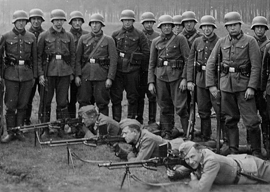
January 11, 2012

Wehrmacht soldiers
This view has become so prevalent among antifascist Germans (there is no other kind now permitted) that in public demonstrations and lavish exhibitions the average Wehrmacht soldier has been turned into the major perpetrator of Nazi murders. On these occasions young people come forth to tell us that their grandfathers or great-grandfathers were most certainly mass murderers. These penitent descendants seem to hope their ancestral nation will soon disappear.
It is against this background of lunacy that Alfred de Zayas, a retired high official from the UN Commission for Human Rights, has released Völkermord als Staatsgeheimnis (Genocide as a State Secret, 2011). Zayas has authored other controversial works that go against the prevalent leftist grain. Among his earlier studies are heavily documented examinations of Eastern Europeans’ organized murders of Volksdeutsche (ethnic Germans) after the Second World War, as well as the postwar agreements that greased the skids for these crimes. Zayas’s works are all painstakingly documented, and his latest study is based on thirty-five years of interviews and a laborious sifting of sources. The author fine-combed the records and testimonies of the Nuremberg Trials in 1946-47 and interviewed surviving “war criminals” including Albert Speer and Admiral Karl Dönitz, the Nuremberg prosecutors, and former war prisoners of the Nazis.
Records from the Wehrmacht Office for the Investigation of Violations of International Law indicate an official willingness to investigate reported crimes against civilians. There is nothing to suggest that these investigators knew about Hitler’s Final Solution. When they received reports about “unwarranted” shootings of civilians in occupied areas, they prosecuted the offenders. Even the judges assigned to the Waffen SS were often in the dark about the Einsatzgruppen’s mission, and sometimes they launched inquiries into reports about mass murders taking place in the east. Even the regime’s enemies—ranging from anti-Nazi aristocrats associated with the Resistance, to persecuted Social Democrats (such as the partly Jewish family of former Chancellor Helmut Schmidt), and even former concentration-camp inmates—had no idea of the Final Solution. According to the official story, Jews were being “relocated” and would be employed in “work divisions” outside Germany. Although this forced evacuation caused some concern among friends and neighbors, what was happening did not look like the beginning of genocide.
The most obvious reason for this is that secrecy was strictly observed. The Holocaust was planned by a small circle meeting outside Berlin in January 1942. In addressing his SS subordinates in Posen in 1943, Himmler boasted about how well their secret was being kept. Other factors worked to keep the secret from getting out: The death camps, as opposed to generic concentration camps, were located in the east, not in Germany. Then from 1943 on, German civilians were subject to Allied bombing and had to protect themselves while enemy forces overran them. In this situation it was unlikely that a war-weary German would wonder about a “relocated” Jewish neighbor’s fate.
Even foreign sources, which were mostly available as radio transmissions, had little to say about the murdered Jews, and being caught using these sources could land the offender in a concentration camp. Germans who found out about the murders couldn’t do much to stop them, since divulging the secret to a government official could be deadly.
Ironically, Zayas confirms findings about the Holocaust that came out of the Nuremberg Trials. Although these trials were planned to make Germans feel ashamed of their country, the judges did not declare all Germans to be complicit in the Holocaust. It was assumed that the mass extermination of Jews was a carefully guarded secret. Very few of those put on trial were sentenced to death or to long imprisonment for planning to murder Jews. Even the prosecutors believed what Zayas tells us concerning knowledge of the Final Solution. Admittedly there were isolated instances of Wehrmacht units participating in the shooting of Jews and other civilians, particularly in Kharkov and elsewhere in the Ukraine. But those were treated as special cases and not seen as typical of Wehrmacht behavior.
It speaks volumes that Zayas—who echoes the post-War, Nuremberg Trial view of who knew what about the Holocaust—is now regarded in some circles as a German apologist. From the warped perspective of today’s German intelligentsia, their country’s post-war humiliation can never go far enough.